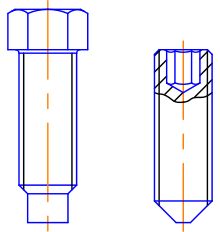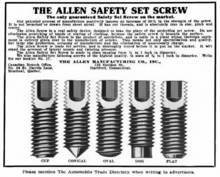Set screw

A set screw is a type of screw generally used to secure an object within or against another object, normally not using a nut (see bolts compared with screws). The most common examples are securing a pulley or gear to a shaft. Set screws are usually headless (also called blind), meaning that the screw is fully threaded and has no head projecting past the major diameter of the screw thread. If a set screw has a head, the thread will extend all the way to the head (whereas a bolt might have an unthreaded shank between the head and thread). A blind set screw (known in the UK as a grub screw, quite possibly from its figurative resemblance to a soil-dwelling grub) is almost always driven with an internal-wrenching drive, such as a hex socket (Allen), star (Torx), square socket (Robertson), or slot. The set screw passes through a threaded hole in the outer object and is tightened against the inner object to prevent it from moving relative to the outer object. It exerts compressional or clamping force through the bottom tip that projects through the hole.

An example application is when a set screw is screwed into a pulley hub so that its end-point bears firmly against the shaft. The fastening action is by friction between the screw and the shaft, often (but not always) with some amount of elastic or plastic deformation of one or both.
Torque resistance or transmission

Set screws are not always the best way to resist the torque of driven shafts. To reduce the chance of slipping and to increase load capacity, a detent (often called a "flat") may be milled or ground at the part of the shaft where the set screw's point contacts. The detent, however, must be closely aligned with the threaded hole prior to fastening. The operator can often feel the screw push the flat into final alignment as he or she makes the last half- or quarter-turn that tightens the screw. Set screws can successfully hold against heavy-torque applications if the details are right. For example, endmill holders of the solid type typically use large set screws holding against flats to fasten the endmill, and heavy loads are resisted. However, small set screws without flats are prone to spinning and galling if overloaded. The use of keys and keyways instead of, or in combination with, set screws is common for applications requiring high torque resistance or transmission. Splines offer yet more strength.
For longer life, set screws are usually made of alloy steel and case hardened. Hardened set screws often leave a plastic deformation, in the form of a circular or semicircular mark, in the shaft that the screw sets against. This has both pros and cons. On the pro side, such deformation increases the holding power (torque resistance) of the joint, as the screw is essentially "making its own detent" on a small but effective scale. On the con side, if one is aiming to have a blemish-free cosmetic finish on the part being set against, one must take actions to prevent the circular marks. In most set screw applications, this consideration is irrelevant. Another con is that this plastic deformation can cause corresponding high points in the shaft surrounding the circular mark. This can result in difficulties during dis-assembly if a bearing or other tightly toleranced part needs to slide past this area. Use of a flat mitigates this problem.
Point types

Set screws appear with a variety of tip (point) types. The different shaped tips have different properties that engineers can utilize. If an engineer were to use a detent to ensure proper nesting of the screw, they might choose to use a cone point type of screw. One might often need to use a flat point when the screw must press perfectly flat against a surface. The most common type is the cup point. This type works well because the surface is rounded so that a small surface area is in contact, but it does not have extremely high stress at one point like that of a cone point. Durability studies show that the cup point offers superior resistance to wear while maintaining a strong grip.[1] Knurled cup points offer the added advantage of a locking action (similar to that of a serrated lock washer) that prevents the screws from working loose in high-vibration applications.[2]
Common points include the following:
- Flat point
- Domed point
- Cone point
- Cup point
- Extended point (pilot point, dog point)
- Knurled cup point
Knurled cup point
Knurl point screws are generally used to secure one object within another. The serrated ridge on the knurl cup set screw helps reduce loosening due to vibration. The knurled point combines digging action of the cup point with counter-clockwise locking knurls that have a ratchet-locking action which helps resist loosening, even under the most severe vibrations.[3][4]
Knurl point set screws should not be reused because the cutting edges of the knurls are deflected when tightened. During removal, the cutting edges are torn and no longer have full strength to resist unscrewing.
Drive types
Set screws are made with a variety of drive styles, including the following:
History
The concept of set screws is many centuries old. Headless set screws have been around for a long time, with the straight slot being the oldest drive type (due to its ease of machining), but the demand for headless set screws experienced a marked increase in the first and second decades of the 20th century, when a penchant for better industrial safety, a campaign with the slogan "safety first",[5] swept the industrialized nations of North America and Europe as a part of the larger Progressive Movement. This surge in safety consciousness was a backlash against the often-atrocious industrial safety standards (or, mostly, lack thereof) during the era of robber baron captains of industry in the Gilded Age. H.T. Hallowell, Sr., a U.S. industrialist whose corporation was one of several that pioneered the commercialization of the hex socket drive, noted in his memoir that line shafting, which was ubiquitous in the industrial practice of the time, often had headed set screws (with external-wrenching square drive) holding the many pulleys to the line shafts, and collars holding the shafts from axial movement. Gear trains of exposed gears were also common at the time, and those, too, often used headed set screws, holding the gears to the shafts. His company's chief products at the time were shaft hangers and shaft collars of pressed-steel construction. The "safety craze" created a burgeoning demand for headless set screws on pulleys, gears, and collars to replace the headed ones, so that workers' clothing and fingers were less likely to catch on the exposed rotating screw head. It was this heightened demand that prompted Hallowell's firm to get into the screw-making business and to explore socket-head drive designs. With P.L. Robertson holding fresh patent rights on a practical-to-make square-socket drive, the firm soon pursued the hex socket drive.
See also
References
- ↑ Kent. (1895). The mechanical engineer's pocket-book. P.978.
- ↑ Hallowell 1951, pp. 59–61
- ↑ https://www.fastenal.com/products/details/81805 Fastenal Company
- ↑ http://www.kdfasteners.com/set-screws.html KD Fasteners, Inc.
- ↑ Hallowell 1951, p. 51.
Bibliography
- Hallowell, Howard Thomas, Sr (1951), How a Farm Boy Built a Successful Corporation: An Autobiography, Jenkintown, Pennsylvania, USA: Standard Pressed Steel Company, LCCN 52001275, OCLC 521866.
External links
| Wikimedia Commons has media related to Set screws. |